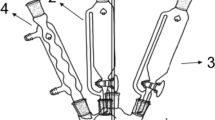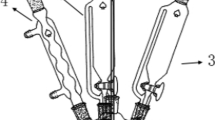Abstract
Usually, the traditional acrylate polymer latex, which is used as the binder of the coatings, is a linear polymer and properties of the latex film cannot meet with the demand of the high-grade coatings. Presently, there are few reports on the polyacrylate latex modified by diallyl malate, i.e. butanedioic acid,2-hydroxy-, 1,4-di-2-propen-1-yl ester (BAHD) and long fluorocarbon acrylate monomer such as dodecafluoroheptyl methacrylate (DFMA) in the open literatures. The purpose of this work is that the cross-linked acrylate latex is prepared which DFMA and BAHD are used as the functional monomer and as a cross-linking monomer, respectively. The cross-linked acrylate latex is prepared which methyl methacrylate (MMA) and butyl acrylate (BA) is used as the main monomers and the non-ionic emulsifier isomeric alcohol polyoxyethylene ether (X-407) and the anionic emulsifier sodium dodecyl sulfonate (SDS) are used as emulsifiers. DFMA and BAHD are used as the functional monomer and as a cross-linking monomer, respectively. Factors which have an influence on the properties of the resultant latex and the emulsion polymerization are investigated in detail. The optimal recipe of preparing the latex is obtained as follows: the amount of mixed emulsifiers is 6% and mass ratio of X-470 to SDS is 2:1. When the amount of BAHD is 4.47%, the water absorption rate is reduced greatly. The glass transition temperature is 10 °C. In compassion with the conventional latex, the thermal decomposition temperature is increased by 10 °C. The resultant latex has good stability and small particle size. The latex film exhibits hydrophobicity and the water contact angle is more than 90°.








Similar content being viewed by others
References
Guan SL (2013) Paint chemistry and technology [M]. Chemical Industry, Beijing, p 67
Wang XR, Yang LL, Zhang WH, Wang XL (2017) Research on the application of cross-linking monomer modified acrylate emulsion. Coat Ind 47(9):29–34
Zhang ZX, Fu GW, Chen RQ, Wang CP (2019) Study on properties of acrylate postcrosslinked emulsion. China Adhes 28(3):1–4
Zhang J, Du M (2009) Properties of self-crosslinking reactive acrylate microgel emulsion and its coating film. Synth Rubber Ind 32(2):109–113
Fei GQ, Wang J, Yang J, Wang H, Yang X, Zhu K (2019) Influence of soft and hard monomers on polysiloxane/acrylate composite emulsion. China Adhes 28(1):6–12
Liu ZG, Ye H, Chao Z, Zhang MY, Li WM, Zhang HX, Liu FQ, Liu WJ (2010) Seeded emulsion polymerization of butyl acrylate using a redox initiator system: kinetics and mechanism. Ind Eng Chem Res 49(16):7152–7158
Gong Y L, Shao TT, Chen LJ (2020) Preparation and characterization of fluorine-containing soap-free acrylic emulsion. Pigment Resin Technol 50(1):41–47
Yang TT, Peng H, Cheng SY, Park IJ (2005) Surface immobilization of perfluorinated acrylate copolymers by self-crosslinking. J Fluorine Chem 126(11–12):1570–1577
Chen YJ, Zhang CC, Wang YF, Cheng S, Chen P (2003) Study of self-crosslinking acrylate latex. J Appl Polym Sci 90(13):3609–3616
Zhang YL, An QF, Yu Y (2013) Synthesis of self-crosslinking fluorine-containing acrylic resin and its application in coatings. Coat Ind 43(09):31–35
Du PH, Xiao XY, Zhang HP, Wan CX (2007) Preparation of self-crosslinking fluorine-containing acrylate copolymer emulsion. Progress Chem Ind 10:1456–1461
Xu W, An QF, Hao LF, Sun Z, Zhao WJ (2014) Synthesis of self-crosslinking fluorinated polyacrylate soap-free latex and its waterproofing application on cotton fabrics. Fibers Polym 15(3):457–464
Chen LJ, Wu FQ (2012) Preparation and characterization of novel self cross-linking fluorinated acrylic latex. J Appl Polym Sci 123(4):1997–2002
Fang C, Zhu K, Zhu XB, Lin Z (2019) Preparation and characterization of self-crosslinking fluorinated polyacrylate latexes and their pressure sensitive adhesive applications. Int J Adhes Adhes 95:1–8
Tuba ÇÇ, Esin H, Ersin S (2013) Synthesis and characterization of perfluorinated acrylate–methyl methacrylate copolymers. J Appl Polym Sci 128(3):1450–1461
Chen LJ, Shao TT, Gong YL (2019) Synthesis and characterization of fluoro-silicone polyacrylate latex emulsified with novel green surfactants. Progress Rubber Plast Recycling Technol 35(2):102–114
Fu GW, Zhang YH, Zhag ZX, Chen RQ, Wang CP (2020) Influence and application of crosslinking monomers on acrylate emulsion polymerization. Chem World 61(10):705–712
Vijayabaskar V, Bhattacharya S, Tikku VK, Bhowmick AK (2004) Electron Beam initiated modification of acrylic elastomer in presence of polyfunctional monomers. Radiat Phys Chem 71(5):1045–1058
Shen YD, He Y, Wang HH, Yang J, Fei G, Yang X (2019) Influence of crosslinking agent on properties of polysiloxane/acrylate emulsion. New Chem Mater 47(1):187–191
Hu Y, Li FY, Zhao TB (2020) Improvement of mechanical properties of hydrophobic fluoroacrylates by cross-linking modification by emulsion polymerization. Electroplating Finish 39(4):188–194
Cao S, Liu B, Deng X, Li S (2005) Core/shell particles containing 3-(methacryloxypropyl)-trimethoxysilane in the shell: synthesis, characterization, and application. Macromol Biosci 5(7):669
Chen YJ, Hou FQ, Qing Q (2013) Research progress on modification of acrylate coatings. Mater Rev 27(Supplement 1):236–240
Lü T, Qi DM, Zhang D, Liu Q, Zhao HT (2016) Fabrication of self-cross-linking fluorinated polyacrylate latex particles with core–shell structure and film properties. Reactive Funct Polym 104:9–14
Yu XL, Chen JF, Liu W (2016) Q.The relationship between the structure of polymethacrylate-based motor units and the glass transition temperature. Polym Mater Sci Eng 32(6):49–53
Li YW, Xu SF, Ma DX (2020) Research on polymer physics teaching in series with glass transition temperature (tg). Polym Bull 9:74–77
Author information
Authors and Affiliations
Corresponding author
Ethics declarations
Conflict of interest
No conflict of interest exits in the submission of this manuscript and manuscript is approved by all authors for publication. I would like to declare on behalf of my co-authors that the work described was original research that has not been published previously, and not under consideration for publication elsewhere, in whole or in part.
Additional information
Publisher’s Note
Springer Nature remains neutral with regard to jurisdictional claims in published maps and institutional affiliations.
Electronic supplementary material
Below is the link to the electronic supplementary material.
Rights and permissions
Springer Nature or its licensor (e.g. a society or other partner) holds exclusive rights to this article under a publishing agreement with the author(s) or other rightsholder(s); author self-archiving of the accepted manuscript version of this article is solely governed by the terms of such publishing agreement and applicable law.
About this article
Cite this article
Chen, L., Cao, S. Preparation and characterization of fluorocarbon latex modified by diallyl malate. J Polym Res 31, 148 (2024). https://doi.org/10.1007/s10965-024-03997-3
Received:
Accepted:
Published:
DOI: https://doi.org/10.1007/s10965-024-03997-3




